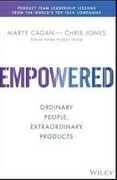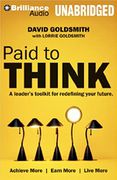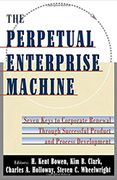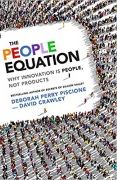
A 5 Minute Overview Of
Empowered
Ordinary People, Extraordinary Results
About the Authors
Marty Cagan is the founder of the Silicon Valley Product Group, a product development consulting company. He previously held senior-level leadership positions with eBay, Netscape, and Continuus Software Corp., as well as being a software engineer with Hewlett-Packard. He has more than 25 years experience building and leading product teams, and today acts as an executive coach and advisor to leading Internet companies. He holds multiple patents, and is a graduate of Stanford University and the University of California, Santa Cruz.
Chris Jones is a partner at Silicon Valley Product Group. He has more than 25 years experience building and leading product teams. He has worked with everyone from startups to Fortune 500 companies, including Lookout, Symantec, and Vontu. He also holds multiple patents in consumer and enterprise mobile, web, data, and platform services. Chris Jones is a graduate of Stanford University.
The Main Idea
How do the top tech companies — like Apple, Google, Netflix, Tesla, Amazon, etc. — keep on coming up with consistent innovations? Most people assume it's because they recruit top talent, but the real advantage these companies have is not so much who they hire, but how they enable their people to work together.

What they do differently is the top companies create an "empowered environment" — where great products and ideas can emerge from a team of otherwise ordinary people working together exceptionally well.
If you want to come up with great innovations in the future, don't look for Superman. Create an empowered environment which genuinely leverages the potential of your people. Help your people work together well, and they will solve hard problems for your customers, and create extraordinary products.
Leadership is about recognizing that there's a greatness in everyone, and your job is to create an environment where that greatness can emerge.
In most companies, the technology teams are not empowered product teams, they are what I call here feature teams. The feature teams get to work first designing the features on the roadmap, maybe doing a little usability testing, and then proceeding to building, QA testing, and deploying the features (known as delivery). In contrast, in strong product companies, teams are instead given problems to solve, rather than features to build, and most important, they are empowered to solve those problems in the best way they see fit. And they are then held accountable to the results.
The Five Elements of Empowered Teams
1. Element #1 — Coaching. Coaching is something that rarely occurs in many companies, but is more essential than ever. The key to having a successful product development team is to use coaching to turn ordinary people into members of extraordinary product teams.
2. Element #2 — Staffing. Coaching and developing your people is important, but so too is finding the right people to begin with. The best product companies hire people of character, and then coach and develop them to become great team members. Staffing and coaching go hand in hand.
3. Element #3 — Product Vision. Most companies have some kind of mission statement which encapsulates the purpose of the business. The product vision states how you plan to deliver on this mission by developing this specific product. A good product vision inspires, compels, and empowers.
4. Element #4 — Product Strategy. Product strategy is all about deciding which customer problems you are going to solve. This is often hard to develop, because people will be hoping to solve all the customers problems, but that's unrealistic. Product strategy is your overall approach and rationale.
5. Element #5 — Collaboration. Strong product leaders and empowered product teams are great, but they're usually not enough. To develop great products, you also need company-wide collaboration happening. This will only become feasible if you move from a subservient business model to a collaborative business model.
Key Takeaways
- Ordinary people can produce extraordinary results if you empower them and coach them the right way.
- A leader's job is to create an environment where people are empowered to do great work.
In strong product companies, technology is not an expense, it is the business. Technology enables and powers the products and services we provide to our customers. Technology allows us to solve problems for our customers in ways that are just now possible. As such, in strong product companies, the purpose of the product team is to serve customers by creating products customers love, yet work for the business.
Summaries.Com Editor's Comments
Very interesting book. Product development guru Marty Cagan teams up with innovation specialist Chris Jones to point out what passes for "product development" in most companies is really just "feature adding" by another name. True product development is where you solve problems the end customer truly cares about and needs solved. When you give a team permission to solve the problem in the best way they see fit, that creates an empowered development team.
The authors also note that these empowered teams are made up of ordinary people who are coached to become extraordinarily productive, rather than superstars at the top of their game. It's the team structure that generates the magic, not the raw talent or the charisma of stars. When you take off the binders and help people work together well, the synergy that gets generated can be quite impressive. Give people problems to solve rather than features to add, empower them to do what makes the most sense to them, and add in accountability, and the end results can be pretty impressive.
Great ideas for managers, business startups, and entrepreneurs right across the spectrum.
Want in-depth 30-minute summaries?
In addition to this 5-minute overview, Summaries.Com has a premium 30-minute summary of this book and 1,000+ more, to help you advance your career and business.
Check Out Summaries.com Premium Plans Today!Want more 5-minute Snapshots?
To get a new 5-minute business book snapshot each week, sign up for the Summaries.com free plan.
Sign Up for the Summaries.com Free PlanProduct Development 101 Collection
If you enjoyed this summary, here is a collection of related business book summaries, to help you get ideas and strategies that will give you an edge over your competition.
This mini-course will give you ideas on how to run product innovation projects.
Buy Product Development 101 Collection (5 x 30-Min Summaries)
Empowered
Ordinary People, Extraordinary Results
by Marty Cagan and Chris Jones

Lean Customer Development
Building Products Your Customers Will Buy
by Cindy Alvarez

The Perpetual Enterprise Machine
Seven Keys to Corporate Renewal Through Successful Product & Process Development
by H Bowen and K. Clark

The People Equation
Why Innovation is People, Not Products
by Deborah Piscione and David Crawley

Weird Ideas That Work
111/2 Practices for Promoting Managing and Sustaining Innovation
by Robert Sutton